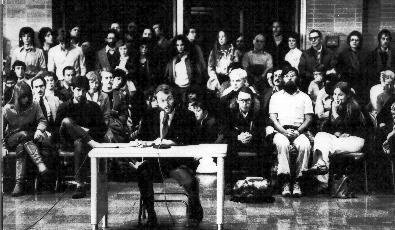Chapter 1: The Anti-Imperialist League 1898-1902
Pages 3 - 4
Chapter 2: The People's Council 1917-1919
Pages 5 - 6 - 7
Chapter 3: The American League Against War and Fascism and the Emergency Peace Campaign 1933-1939
Pages 8 - 9 - 10
Chapter 4: The Progressive Citizens of America 1946-1948
Pages 11-12
Chapter 5: The "Mobes" against the Vietnam War 1966-1970
Pages 13-14
Chapter 6: The Nuclear Freeze Movement and People-to-People Diplomacy 1980-1990
Pages 15-16-17-18
Chapter 7: Global Movement for a Culture of Peace 2000-
Pages 19-20-21
Chapter 8: The Root Causes of War
Pages 22-23-24-25-26-27
Chapter 9: The Future of the Peace Movement
Pages 28-29-30-31
Acknowledgements
Page 37
The success of the "nuclear freeze" idea, initiated in 1980 by a young disarmament researcher, Randall Forsberg, caught many by surprise. It was not caused by an actual war, but by the increased threat of war associated with the U.S. Senate's failure to ratify the SALT II arms control agreement that had already been negotiated with the Soviet Union, and by Carter's Presidential Directive 59 that made plans for a first strike nuclear war. The movement also was fueled by a massive diversion of federal funds and increased federal debt to pay for the largest arms buildup in the history of the world (note 10).
Much of the success of the Freeze campaign was due to the simplicity and clarity of its program. It called on the U.S. and Soviet Union to "adopt a mutual freeze on the testing, production, and deployment of nuclear weapons and of missiles, and new aircraft designed primarily to deliver nuclear weapons." The Freeze struck right to the heart of the military buildup ordered by President Carter and later continued by Reagan in order to generate business and profits for the military-industrial complex. After considerable internal debate (the Freeze did not call for British, French or Chinese participation. but was only bilateral), the Soviet Union agreed to support the Freeze proposal at the United Nations.

|
| Figure 6. A New England town meeting votes for the Freeze - 1982 |
The Freeze campaign culminated in the 1982 rally at the United Nations, the 1982 ballot referendums, and the 1984 race for the Democratic presidential nomination. The 1982 rally was the largest in the entire nation's history, bringing a million people to Central Park in association with the United Nations special session on disarmament. It was organized by a coalition of 130 organizations reminiscent of the breadth of the Vietnam Mobes. Local Freeze and other anti-war groups then placed the question of the Freeze on the November election ballots where it passed by overwhelming majorities. According to the New York Times of November 4, 1982, "the voting on the resolution, which is purely advisory, constituted the largest referendum on a single issue in the nation's history." In the 1984 elections, the Freeze was supported by practically all of the major contenders for the Democratic nomination for President, and the convention was packed with Freeze supporters. Although Mondale won the nomination, claiming to support the Freeze, in the campaign itself his position was even more militaristic than Reagan's, as seen in the televised foreign policy debate. Mondale's fai1ure to present a strong peace position probably contributed to his defeat in the election.
(continued on next page)
 |
 |
 |